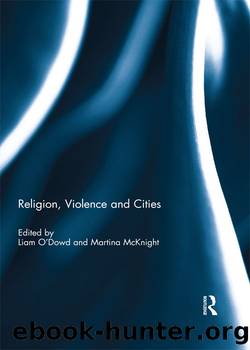Religion, Violence and Cities by Liam O'Dowd & Martina McKnight

Author:Liam O'Dowd & Martina McKnight [O'Dowd, Liam & McKnight, Martina]
Language: eng
Format: epub
Tags: Political Science, General
ISBN: 9781138821262
Google: feKnoAEACAAJ
Goodreads: 22481269
Publisher: Routledge
Published: 2014-11-01T00:00:00+00:00
Cities Contested, Divided, Re-United and âCleansedâ: Pathways of Violence as Indicated by Trajectories of Intersecting Religoscapes
Trajectories of intersecting religioscapes will generally indicate the condition of social relations within cities. Such a case is one in which a new religious community arrives at or develops within a city. In such instances, we should look for whether the nodes of the religioscapes reflect the achievement of dominance by the new groupâenvision Constantinople after May 29, 1453. In such a case, some of the shrines of the newly subjected may remain, but we would anticipate that they would be less central and less perceptible than those of the newcomers.
A city may become contested and then divided. In such a case, we would look for the transformation of the spatial distribution of the nodes of each religioscape, and also of efforts within the divisions to reduce the perceptibility of the other groupâs sites while increasing the perceptibility of their own. At the same time, we would not anticipate the total removal of all of the other groupâs sites, in part because once patterns of dominance are re-established, peaceful co-existence can resume and is facilitated by permitting the dominated to retain some of their own religious sites. We note the continued presence of Byzantine churches in Anatolian towns up until 1923, or the continued functioning of single mosques in Belgrade, NiÅ¡, Sofia and other cities in Balkan states newly independent of the Ottoman Empire and basing their national identity on their Christianity (Hayden, 2005). Sarajevo during the 1992â95 war was both contested and divided, and we return to it at the end of this article. Also of interest is Nicosia following the independence of Cyprus, in which the Turkish Cypriot population was besieged in âenclavesâ from 1963â74 and developed an unrecognised state structure that set the stage for the proclamation and structuring of the Turkish Republic of Northern Cyprus nine years after the Turkish invasion liberated the enclaves and forcibly partitioned the island (Bryant and Hatay, 2011). We now look at this case in more detail.
Download
This site does not store any files on its server. We only index and link to content provided by other sites. Please contact the content providers to delete copyright contents if any and email us, we'll remove relevant links or contents immediately.
The Secret History by Donna Tartt(18860)
The Social Justice Warrior Handbook by Lisa De Pasquale(12143)
Thirteen Reasons Why by Jay Asher(8800)
This Is How You Lose Her by Junot Diaz(6802)
Weapons of Math Destruction by Cathy O'Neil(6152)
Zero to One by Peter Thiel(5692)
Beartown by Fredrik Backman(5609)
The Myth of the Strong Leader by Archie Brown(5429)
The Fire Next Time by James Baldwin(5252)
How Democracies Die by Steven Levitsky & Daniel Ziblatt(5133)
Promise Me, Dad by Joe Biden(5088)
Stone's Rules by Roger Stone(5027)
A Higher Loyalty: Truth, Lies, and Leadership by James Comey(4851)
100 Deadly Skills by Clint Emerson(4845)
Rise and Kill First by Ronen Bergman(4705)
Secrecy World by Jake Bernstein(4652)
The David Icke Guide to the Global Conspiracy (and how to end it) by David Icke(4629)
The Farm by Tom Rob Smith(4442)
The Doomsday Machine by Daniel Ellsberg(4420)
